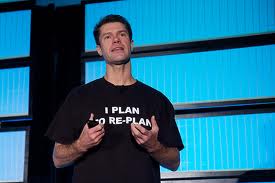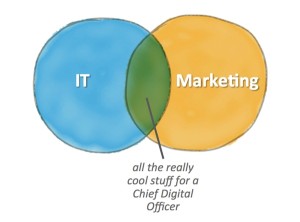I had a chance to sit down with Luke Hohmann, founder of Conteneo, Inc. and creator of Innovation Games® and Knowsy® to discuss how serious games are changing Sales and Marketing teams at major brands. The following is a transcript of our conversation.
PD: Talk a little bit about what is a “serious” game. How does that differ from just a game?
LH: A serious game is a game that we play to solve a business problem as opposed to any other kind of game typically played for entertainment purposes. When I’m playing Scrabble with my wife on a Saturday night, we’re just enjoying the company and the time together, and there’s nothing really serious about it. When I play a serious game, I’m trying to solve some kind of a business problem like managing a complex sale or developing a product-marketing plan.
PD: Why are they becoming so popular? What’s driving the popularity of some of these games?
LH: The reason serious games are becoming so popular is because we’re learning that when people are playing games, their brain is literally in a different state. When you’re playing a game like Angry Birds, tiny amounts of dopamine are released every time you achieve the next level in the game or create a new high score. This dopamine, in turn, makes you happy and motivates you to play more – achieve the next level, reach a new high score.
We’re finding we can take some of those feelings of positivity that occur when people accomplish a goal and put them into a work context. For example, let’s say you need to make choices on where you’re going to invest your marketing dollars across various social media challenges. This is a classic portfolio management question.
Unfortunately, traditional ROI approaches to portfolio management often leaves you feeling beat up and hollow when you’re done, because you’re trying to argue about uncertain futures using only half of your brain.
Our collaborative games-based approach to making these choices leaves you and your entire team feeling energized because in the game you can explore both ROI and non-ROI factors to selecting your social media investments. When you achieve the goal, you’re going to feel great about the result, because along the way the game will induce your brain to release some dopamine while you’re playing.
That’s similar with Knowsy in the sales context. A traditional way that strategic sales managers determine the priorities of a buyer or get a group of stakeholders that influences the buying decision aligned is usually a sequence of painful meetings in which salespeople interrogate their prospects. Knowsy shortens the buyer alignment process by engaging buyers in a meaningful, collaborative and fun activity that results in people feeling good about the alignments that they’ve created and the paths they agreed to take. And yup, the dopamine released during the game, and the behavioral economics theory that underpins the choices in the game, all help your sales team close complex deals faster.
PD: Let’s go into some examples of how sales teams have solved potential business problems.
LH: One of our clients, Serena Software, makes a software application that help large companies manage the flow and upgrade of other software applications on mainframe systems. So if you’re a bank or insurance company and you have an old mainframe system you want to update, Serena makes software that makes the upgrading process easier. Typically, Serena’s sales involve a number of influencers: the CIO, the head of application development, the head of data security, the head of operations, all of whom need to be comfortable that Serena is the right solution to not only meet their corporate IT needs but also their individual departmental priorities. The traditional approach of a salesperson trying to make that sale is like herding cats and chasing after one-on-one meetings. The salesperson spends inordinate amount of time setting up interviews to understand individual stakeholder’s priorities, one at a time. Of course, when the salesperson brings the group together, he must present a slide deck that magically shows how his solution is going to meet everyone’s number-one priority.
But if you look at the discussion in that room that ensues, it is slow and painful, because suddenly the buyers realize that while they might know their own individual priorities, they probably do not know the priorities of their peers. And they think: “We’d better talk about our shared priorities, because if we are going to purchase Serena’s solution, it will affect everyone, but individually and as a team. So we’d better figure out what our priorities are and how we want to go forward.” The most effective salespeople know that they need to skillfully facilitate that meeting so the sales process doesn’t stall or slow down due to lack of internal customers’ alignment.
What Knowsy does is it tackles that situation head on. When you’re in a complex sale, the salesperson calls his prospects and says I want to have this meeting. I want to bring in the key players into the room. And I’m going to lead you through a guided activity that will reveal your priorities and help you reach alignment as a team. When that’s done, if the priorities of the group are such that my solution can be useful, we’ll figure it out and we’ll move forward. If it’s not, we’ll discover this soon enough as a team.. Either way, we all win because the priorities of the individual stakeholders will be revealed, and we’ll be able to see if there’s internal alignment to progress down the buying process.
PD: Let’s go to marketing team. Can you give us some examples of how either a corporate team or maybe even a product team might use Knowsy?
LH: Even though Knowsy is a tool for salespeople, we’re finding that the people who are bringing our tool into their organizations are, in fact, marketing departments. The marketing team tells us two things. One, they’re never in the room with the salespeople when the salespeople are reviewing prospects’ needs and, therefore, they’re never really sure what messages are resonating, what are the important trends and what are the important priorities. The idea behind Knowsy is that by playing this game in a fun and engaging way, you’re actually feeding a real-time database that the marketing team can use.
On the flipside, the other thing that the marketing departments that we’ve been working with have told us repeatedly is that they have expertise and a point of view about their industry that they want to communicate. Many marketing departments want to establish their employees as thought leaders. So what we do in Knowsy is we take those thought leaders and we put their opinions into the platform about what a prospect might do in a certain situation. Prospects can compare their opinions individually and/or as a team with recognized thought leaders from the company or the industry.
What that does is it lets the marketing department promote thought leadership in the most direct manner possible, which is when the buyers are most interested in hearing the opinion of an expert.
PD: Let’s switch to big brands. Can you give us some examples of how big brands are deploying serious games?
LH: A recent advergame that actually is doing very well is Plantville from Siemens. An advergame is a game that is an advertisement disguised as a game. In this case, Plantville is a thinly-veiled version of Farmville. In Plantville, you’re a facilities manager inside a manufacturing plant, building your plant and operating it using the same kind of principles of building and operating your farm in FarmVille. And by playing this simulation game, you learn about Siemens technologies that solve certain problems in plant management, and you can test your knowledge of how to be a good plant manager.
You might assume that the last thing someone who works in a plant all day would want to do is play a game where they operate and manage a plant – and you’d be wrong. What we’re finding is that some of the most-devoted users of Plantville are in fact plant managers of significant facilities who want to demonstrate through various game mechanics that they are really good at their job. Of course, in the process Siemens is getting tremendous brand goodwill and educating the players on new products and features. For example, a plant manager who has an existing set of equipment might not have an ability to explore the operating characteristics of new equipment. But in Plantville, they can try that new equipment and get a sense of what it would do or not do in a simulated environment. It’s a tremendous value to Siemens’ marketing department, of course, to deploy Plantville as a brand engagement tool that effectively reaches its target audience and communicates the features and benefits of Sieman’s products and services.






